Zeiss Victory Harpia 95mm Spotting Scope
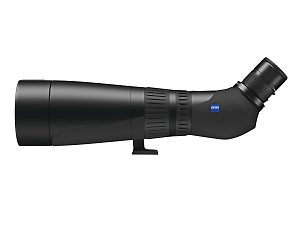 |
|
Click image to enlarge
|
|
Review Highlights
- Zeiss's Victory Harpia 95mm spotting scope
- Wide field of view
- Dual speed focus on a single ring
- Zoom is on the body
|
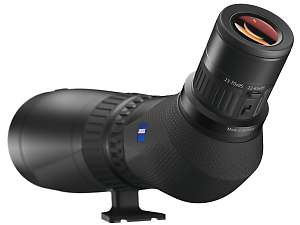 |
|
Click image to enlarge
|
Zeiss recently released a new spotting scope, the Victory Harpia. With Zeiss, the “Victory” product name tells you that
this is their highest level of optical quality. Naturally, we were excited about the prospect, wondering what we’d get
to play with. This sort of thing happens all the time, but at the same time, it’s not a very frequent event. On the one
hand, there are many optics manufacturers out there, innovating and releasing new products to the market, so it happens
all the time. On the other hand, this is Zeiss, arguably one of the very best optics manufacturers on the planet, so in
fact, a scope of this quality appearing on the market is not all that common an event. Zeiss Victory Harpia scopes come
in two objective lens sizes, at 85 and 95 mm in diameter. We received a 95-mm Harpia scope for review.
Dimensions
The first thing you need to know is, this is a beast of a scope! At 95-mm of high-quality, high-density glass, the scope is
heavy, even before you add the metal frame and rubber armoring. We weighed the scope with the objective lens cap on, and it
came to 5 lbs., 2.4 oz (2.3 kg). Per Zeiss, the 85-mm version weighs about 4.7 lbs. (2.1 kg). That tells you one thing
immediately: you will need a full-size tripod to use this scope because tripod weight is required to counter-balance the
optic safely, or you’re perpetually at risk of knocking it over. At the same time, you will probably want to opt for a
carbon-fiber tripod – no sense in adding any more weight than you absolutely must to the total package you’ll be carrying
in the field. The scope is 17.75 inches (45.1 cm) long from the lens hood to the far tip of the zoom eyepiece and 4.25
inches across (10.8 cm) at the widest part of the lens hood. The rubber armoring is completely matte black but for the
small blue and white Zeiss logo on the prism housing. There is an intrinsic lens hood that slides out over the objective
lens. We strongly recommend getting in the habit of using it. Not only does the hood improve the quality of the view by
reducing flare, but it can also protect the scope if someone knocks it over.
Eyepiece/Optical Properties
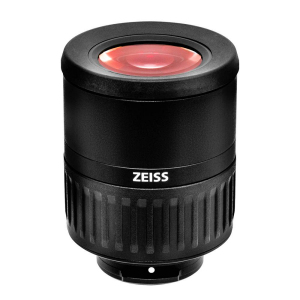 |
|
Click image to enlarge
|
Zeiss made it easy on potential Harpia scope buyers by not overburdening them with choice. Harpia scopes are available
only in angled configuration. Further, there is only one eyepiece available for these scopes: the Victory Harpia eyepiece.
This eyepiece has a helically adjusting (“twist-up”) eye cup to provide a range of eye relief for users. It’s deliberately
stiff, so that it resists against the loss of intermediate positions. The lens system is made entirely from fluorite glass
for superb chromatic aberration reduction (we never saw ANY in the field) as well as excellent light transmission. The
closest focusing distance was 14.7 feet (4.5 meters). This seems like a curious property to mention on a scope since the
whole point of scopes is to see things that are far away better! We concede that - it’s simply one of the things you
measure to get a handle on an optics product.
Focusing
This property is essentially unique to Zeiss scopes, so it deserves its own section to describe it. Like their Conquest
Gavia scope line, the Zeiss Victory Harpia scope has a single, collet-type, dual-speed focus ring mechanism. That’s a lot
of words. In this case, it means that focusing is achieved with a ring that encircles the scope body, and that the
mechanism has two “gears”: a fine focus and a coarse focus, combined in one ring. That mechanism takes a little getting
used to in the field. The way it works is, initial movement of the ring is always in fine-focus mode; to get to course
focus, you must turn the ring harder. We spent days blowing right past the focal plane we wanted and working our way back!
But when we got used to it, exquisitely fine and rapid focus was easy to achieve with this mechanism. It made going back
to the dual-knob mechanism of other scopes feel a bit kludgy though!
Magnification, Zooming and Field of View
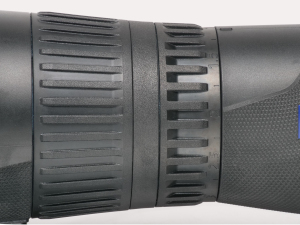 |
|
Click image to enlarge
|
And even though it’s not a function of focusing per se, the magnification/zoom function requires discussion here too. Most
conventional scopes have the zoom function on the eyepiece, but the Harpia does it differently. On the Harpia, the zoom
function resides in a ring on the scope body, rather than on the eyepiece. It is controlled with a narrow ring closer to
the ocular end of the scope. The dual-speed focus knob is a wider ring, closer to the objective end of the scope. Where the
focus ring turns with very little resistance, the zoom ring features a fair bit of resistance. Thus, you can easily
distinguish between the two rings on touch alone. Though both the 85- and 95-mm versions of this scope use the same eyepiece,
as noted above, they have intrinsically different magnification ranges. On the 85-mm model, this zoom eyepiece offers a range
of 22-65x magnification. On the 95-mm model, the magnification range is 23-70x. That translates to fields of view of about 190
feet (58 yards) on the 85-mm version, and roughly 176 feet (54 yards) on the 95-mm model at 1000 yards. Metric system, that’s
54 meters at 1000 meters for the 95x, and 58 meters at 1000 meters on the 85-mm model. So how do these fields of view stack up
against the competition? We tested the Harpia against two other high-end spotting scopes of equivalent size that are in the
same price and quality neighborhood. The results were quite clear: the Zeiss scope had an obviously larger field of view. You
can argue that field of view isn’t tremendously important on a spotting scope, but that really over-simplifies things. If you
are trying to identify a specific bird, then yes, field of view is not of any great utility. But if you are in search mode
rather than ID mode, a larger field of view can be really important. Think of surveying a large reservoir packed with waterfowl
for a Christmas Bird Count; the larger your field of view, the easier it is to accurately count the flock. Or, think of sifting
through a vast flock of small shorebirds, looking for that one bird that is different, that hint of rust that might be the cap
of a Sharp-tailed Sandpiper…
Case and Caps
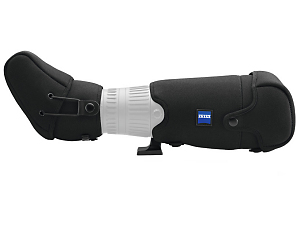 |
|
Click image to enlarge
|
The scope does not come with any kind of padded case included, but Zeiss does offer one for sale separately. This case, costing
about $200.00 for either scope model, is a two-piece padded leather design, with one part strapping over the eyepiece and the
other part fastening to the objective end. The case is designed to always remain on the scope. To use the scope, just open flaps
on both ends to view through the case. The lens caps are both made of pliable black rubber, and they fit very tightly on the
optic and cannot be dislodged accidentally if seated properly. The ocular lens cap is tethered to the eyepiece itself, so it
will be difficult to lose this in the field!
Conclusions
A lot of these things come down to taste. We always recommend that customers visit a store and handle their potential optics,
because there are differences between brands and models and not everyone wants, needs or likes the same features. Optically,
there isn’t a whole lot of difference when you are talking about the highest quality scopes from the very best optics
manufacturers. So then the question becomes: why buy a Zeiss scope as opposed to someone else’s? A couple of reasons jump
right out at us. The dual-speed focus mechanism is really slick, and it’s unlike anything else on the market. If you try it
and like it, there’s no substitute for it. Also, when you buy from Zeiss, you get not just a product, but the company behind
it. Their customer support is excellent. And you know that if something happens to your scope down the road, Zeiss, as an
established international company, will always be around to make things right again. If you’re looking for a scope for the
rest of your life, you owe it to yourself to take a good long look through the Victory Harpia scopes. We think you’ll like
what you see.
Buying Details
The 95-mm Zeiss Harpia scope body (including eyepiece) sells for $4,199.99;
the 85-mm body costs $3,799.99. The Harpia
eyepiece runs $800.00. These prices are comparable
with the highest quality scopes from other fine optics manufacturers.
To purchase a Zeiss Victory Harpia spotting scope visit
here. Through December 31, 2019, purchase a bundle to get the eyepiece for free!